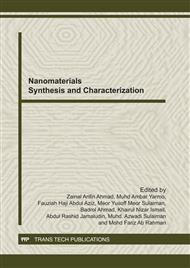p.1
p.7
p.12
p.16
p.20
p.25
p.30
p.35
Role of Carbon Source in the Synthesis of Carbon Nanotubes via Catalytic Chemical Vapour Deposition
Abstract:
Development of technology in synthesizing a novel nanoscale material has been the main concern in the current material science. This study investigates the effect of two different carbon sources on the formation of carbon nanotubes (CNTs) via catalytic chemical vapour deposition (CCVD) method. Two types of carbon source i.e. acetylene gas and ethanol liquid were used for the synthesis of CNTs. The catalysts used in the synthesis of CNTs were formulated from nickel (Ni), copper (Cu) and praseodymium (Pr) using the wet impregnation method. The as-synthesized CNTs obtained were characterized using field emission-scanning electron microscope (FE-SEM), Thermal gravimetric analysis (TGA) and transmission electron microscope (TEM). The analysis result confirmed that the prepared catalysts were active for the production of CNTs. TEM analysis revealed that different morphologies of CNTs were formed when different carbon source was used. FE-SEM micrographs confirmed that acetylene proficient in producing multi walled carbon nanotubes (MWCNTs) and ethanol in producing heterojunctions CNTs with diameter range of 60 to 120 nm and 10 to 40 nm, respectively. Meanwhile, TGA analysis revealed thermal stability of each type of CNTs at different temperature of decomposition. Generally, this research has successful produced different types of CNTs when different carbon source is used.
Info:
Periodical:
Pages:
16-19
Citation:
Online since:
October 2011
Authors:
Keywords:
Price:
Сopyright:
© 2012 Trans Tech Publications Ltd. All Rights Reserved
Share:
Citation:


